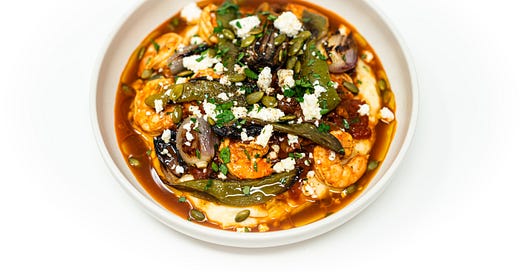When Tortilla-Making Led to the Best Shrimp and Grits I've Ever Made
How childhood memories of Tampa's shrimp docks inspired a Southern classic with a Mexican soul
You know that moment when you're doing something completely routine, and your brain makes this wild connection that changes everything? That's exactly what happened to me a few weeks ago, and it led to what might be the best shrimp and grits I've ever made.
I was in the middle of my usual weekend tortilla-making session, something I've gotten pretty obsessed with lately. There's something deeply satisfying about working masa harina into dough, rolling it out, and watching those perfect pockets of steam puff up on the comal. Once you do this once, you'll never go back to store-bought chips or tortillas.
But as I was stirring the masa with water, watching it transform into this smooth, creamy consistency, something clicked.
What if I treated this like polenta instead of tortilla dough?
The connection made perfect sense. Growing up in the coastal Southeast United States, shrimp was abundant. And pairing it with grits was like gospel. Creamy, comforting, unapologetically rich, but always with that low-country backbone.
My attachment to shrimp runs deep. Growing up in Tampa, I drove past the shrimp docks off Causeway Boulevard almost daily. It was one of the coolest perspectives of the city - a working commercial port with shrimp boats in the foreground of the cruise terminal and downtown Tampa skyline, with Ybor City appearing on the horizon. The docks were a commercial operation but open to the public, and I was fascinated by these weathered boats with their distinctive rigging, fresh from the Gulf with their hauls.
What I didn't fully understand then was that I was witnessing the tail end of an era. As Cigar City Magazine documented, Tampa Bay's commercial fishing industry was under siege - from pollution, industrial competition, and waterfront development pricing out generations of fishing families like the Richards, who had been pulling shrimp from these waters since the 1950s. There's something so cool about watching an industry that feeds people, right there in the heart of a bustling city, that stays with you, especially knowing those boats represented a way of life quietly disappearing while the city grew around it.

Maybe that's why this masa moment felt so significant. Here I was, stirring corn into something creamy and comforting, thinking about shrimp - connecting two traditions that had never met but somehow belonged together. As I stood there at the stove, watching the masa thicken, I realized it had the same soul as those childhood memories. Just from a different part of the map.
So I leaned into it. I cooked the masa low and slow, whisking in butter and a little cotija cheese until it hit that perfect balance between silky and structured, like Southern grits with a Mexican accent.
Then came the shrimp: sautéed with paprika, cumin, and chili powder, just until juicy. But as I was assembling everything, I realized something was missing. All that richness from the masa and cheese needed something to cut through it, something bright to balance the dish.
That's when the tomato broth idea hit me. Tomatoes and corn are natural partners. Think about every great salsa, how perfectly pico de gallo works with corn tortillas. The acidity would brighten everything while complementing the corn flavor instead of fighting it.
So I built this simple but layered tomato broth with garlic, oregano, thyme, tomato paste, and a splash of red wine vinegar for that bright pop. When I spooned it over the masa and shrimp, everything suddenly clicked into place. The acidity cut through the richness, the tomato enhanced the corn, and all these disparate elements felt like they belonged together.
I charred poblanos, bell peppers, and shallots in the same skillet, letting them blister and soften before piling everything high over that creamy masa. A final shower of cotija, toasted pepitas, fresh cilantro, and lime tied it all together.
It wasn't traditional, but it felt right; shrimp and grits reimagined through a masa lens. It's bold, grounded, and honestly better than anything I grew up with.
As Charleston Magazine notes, this dish has deep roots - Native Americans were making the original grits from parched corn as early as the 1680s, and Charleston families have been serving "this dainty little crustacean" for breakfast since the 1800s.
What excites me most about this dish is how it represents the way cooking actually happens in real kitchens. It's not about perfectly planned fusion concepts or elaborate techniques. It's about being curious, making connections, and having the confidence to follow an idea wherever it leads.
I was reminded of how powerful this dish can be just this past weekend at Southern National in Atlanta, where chef Duane Nutter's Gulf seafood and grits connected his Louisiana roots to that same coastal tradition. It's exactly the kind of dish that shows how the best Southern cooking honors its past while never feeling stuck in it.
Sometimes the best innovations come from simply paying attention to what you're already doing. I'd been working with masa harina for months, but it took slowing down and really thinking about it to see the possibilities.
Tradition is a starting point, not a destination. Shrimp and grits will always be special to me. It's symbolic of where I've grown up and lived. But that doesn't mean it can't evolve, can't pick up new influences and become something even better.
Get the recipe here: Masa Polenta Grits with Charred Vegetables and Tomato Broth
And if you’re in the mood for something a little different...
Vancouver’s got over 70 breweries, but these six stood out. Funky taps, wild flavors, and a whole lot of character. If you’re planning a visit, or just want to feel like you are, this one’s worth a watch.





